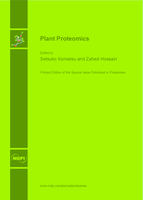Plant Proteomics
A special issue of Proteomes (ISSN 2227-7382).
Deadline for manuscript submissions: closed (30 June 2014) | Viewed by 102239
Special Issue Editors
Interests: gel-free/label-free proteomics; plant physiology; crop; abiotic stress
Special Issues, Collections and Topics in MDPI journals
Interests: plant proteomics; plant stress biology; abiotic stress response; plant antioxidant defence
Special Issues, Collections and Topics in MDPI journals
Special Issue Information
Dear Colleagues,
Proteomics, the high-throughput “omic” technique has validated its role in precise identification and characterization of individual components of plant protein networks. A comprehensive understanding of plant response mechanism is essential to elucidate the key factors affecting plant performance under adverse conditions. Various proteomic approaches that are being exploited extensively for elucidating plant response largely include gel-based and mass spectrometry-based methods that involve both label-based and label-free protein quantification. Despite of limitations in identifying low-abundance and hydrophobic proteins, exceedingly large or small proteins, as well as basic proteins, gel-based method has been accepted as a global tool to unravel the underlying molecular mechanism of stress signal perception and transduction in plant defense responses. Moreover, recent advances in the mass spectrometry-based approaches provide a better opportunity to dissect stress signaling cascades. Nevertheless, complete protein extraction from different plant organs or subcellular organelles is the most challenging facet of plant proteome analysis. Furthermore, protein-protein interactions and post-translational modifications provide deeper insight into protein molecular function. We welcome submissions of original research papers and review articles addressing recent advancements as well as strengths and shortcomings of various proteomic approaches and diverse applications of plant proteomic techniques to get new insights of plant molecular responses to various biotic and abiotic challenges.
Prof. Dr. Setsuko Komatsu
Dr. Zahed Hossain
Guest Editors
Manuscript Submission Information
Manuscripts should be submitted online at www.mdpi.com by registering and logging in to this website. Once you are registered, click here to go to the submission form. Manuscripts can be submitted until the deadline. All submissions that pass pre-check are peer-reviewed. Accepted papers will be published continuously in the journal (as soon as accepted) and will be listed together on the special issue website. Research articles, review articles as well as short communications are invited. For planned papers, a title and short abstract (about 100 words) can be sent to the Editorial Office for announcement on this website.
Submitted manuscripts should not have been published previously, nor be under consideration for publication elsewhere (except conference proceedings papers). All manuscripts are thoroughly refereed through a single-blind peer-review process. A guide for authors and other relevant information for submission of manuscripts is available on the Instructions for Authors page. Proteomes is an international peer-reviewed open access quarterly journal published by MDPI.
Please visit the Instructions for Authors page before submitting a manuscript. The Article Processing Charge (APC) for publication in this open access journal is 1800 CHF (Swiss Francs). Submitted papers should be well formatted and use good English. Authors may use MDPI's English editing service prior to publication or during author revisions.
Keywords
- plant proteomics
- methodologies for plant proteomics
- application of plant proteomics








